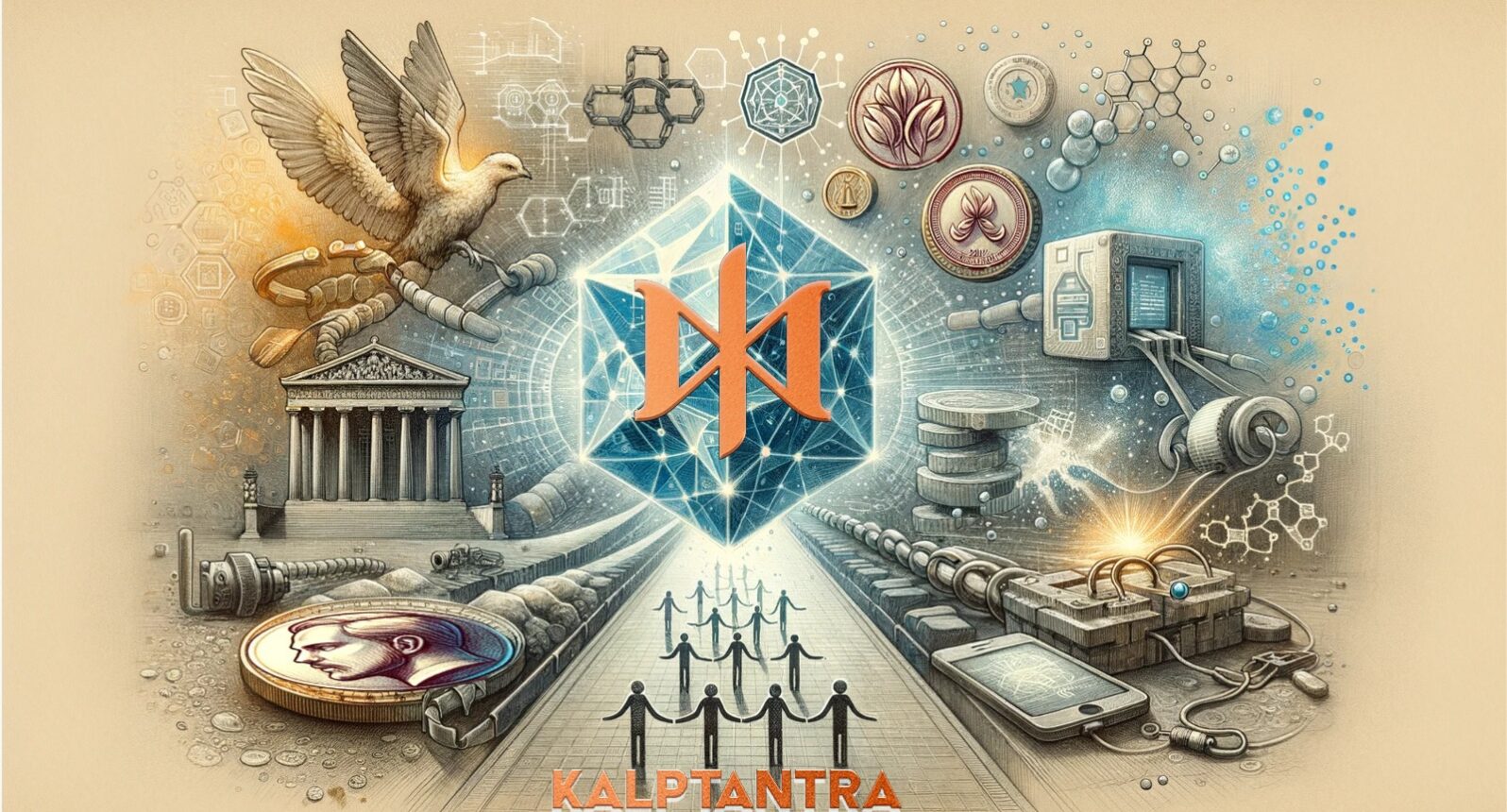At Mai Labs, we were intrigued by the possibilities of programmability, composability, and tokenization enabled by blockchain technology. We set out to explore operationalizing these capabilities to solve real-world problems – along with the associated risks and how to mitigate them responsibly. Our development process focused on financial stability, consumer/investor protection, market efficiency, competition, and preventing financial crime – the key mandates regulators typically consider. With this lens, we worked to enable accountable innovation that ensures safety, soundness, and fairness. This led to the creation of Kalptantra – a regulated blockchain ecosystem engineered from the ground up to bridge the physical and digital worlds while upholding public interest. Mai’s vision was to unlock blockchain’s potential while enshrining compliance and oversight into its decentralized design. Kalptantra represents the culmination of that vision.
Kalptantra offers a pioneering blueprint for building blockchain ecosystems prioritizing regulatory compliance and oversight. Through meticulous multi-layered engineering, it bridges the physical and digital worlds in a decentralized yet accountable manner.
We began by studying the challenges faced by regulators worldwide regarding blockchain networks. Permissionless, public blockchains have repeatedly demonstrated issues around money laundering, investor losses, fraud, market manipulation, and systemic risks. In contrast, Kalptantra implements a permissioned, KYC-verified structure bringing accountability to the network.
The Need for Thoughtful Integration
As blockchain technology has gained traction, its decentralized approach has often been positioned as disruptive to legacy institutions. However, prudent integration of these paradigms may hold the key to progress.
Permissionless blockchains bear fundamental conflicts with the compliance, security and risk management protocols underpinning modern finance. Operating within regulatory boundaries requires reimagining blockchain’s possibilities.
Simultaneously, despite their strengths, prevailing financial systems suffer from opacity, inaccessibility, high costs and slow settlement speeds. Blockchain innovations can help address these limitations in a socially responsible way.
Kalptantra envisions a middle path to synthesize traditional banking with decentralized architectures. Thoughtful fusion of these realms enhances their individual strengths while overcoming innate limitations.
Philosophy: Compliance by Design
Kalptantra’s design process has centered around compliance. Most blockchain projects focus narrowly on decentralization first, leaving compliance as an afterthought. We inverted this approach.
By prioritizing regulatory requirements, Kalptantra enshrines compliance, security and accountability into its technical and governance architecture. The blockchain’s decentralized integrity emerges as a consequence, not a compromise, of constructing guardrails.
The core philosophy behind Kalptantra is prioritizing public benefit over unilateral innovation. We questioned our own assumptions critically at every step. Aligning with the law of the land continues to be integral to our development. We engage seriously with regulations to uphold their intent, questioning our own assumptions critically.
Above all, Kalptantra endeavors to bridge physical and digital dimensions holistically while enriching, not disrupting, existing institutional frameworks.
Architecture: Components of an Ecosystem
Transcending isolated applications, Kalptantra offers an ecosystem with interdependent components working in harmony:
1. Permissioned Blockchain Infrastructure
Kalptantra utilizes a permissioned consortium blockchain architecture. All participants undergo verification to access the network. This accountability enables compliance without compromising decentralization.
Network nodes are operated by verified entities globally, including regulators. Smart contracts encode compliance rules, automating adherence. The crash fault tolerant consensus mechanism prioritizes security and uptime.
2. Decentralized Governance Framework
Innovative decentralization mechanisms distribute authority across diverse coalition groups to safeguard the network:
- Leadership roles rotate periodically to prevent power consolidation.
- Major decisions require multi-signature consensus to prevent unilateral control.
- All activities are immutably recorded for transparent public auditability.
3. Coalition for Accountable Governance
Another important feature of Kalptantra is its coalition blockchain model. Along with verified participants, Kalptantra’s permissioned network is operated by a diverse coalition of partners including businesses, developers, and regulators.
These groups run blockchain nodes, enabling true decentralization across trustworthy entities. Select members also participate in clustered certificate authority roles to provide oversight. By distributing authority across this accountable coalition, Kalptantra retains the resilience of decentralization while enabling compliance and effective governance. The coalition structure creates built-in checks and balances, preventing consolidation of power. It allows businesses to harness blockchain’s benefits responsibly while maintaining regulatory collaboration.
Kalptantra’s decentralized coalition architecture establishes the foundation for the controlled integration of blockchain into mainstream finance.
4. Holistic Compliance Frameworks
Multilayered compliance practices encompass identity verification, transaction monitoring, anomaly detection, external audits, failsafe mechanisms and more.
Compliance is not limited to a single contract or component. It is holistically embedded across the entire technology stack and organizational operations.
5. Scalable Architecture Through Sharding
In developing Kalptantra’s multi-chain permissioned ecosystem, sharding methodology was employed to enable modular and scalable architecture.
The blockchain infrastructure is partitioned into smaller, independent shards that process transactions in parallel. This sharding dramatically increases throughput and reduces latency as the network grows. In a permissioned environment, shards can be strategically optimized given known participants.
Kalptantra thus unlocks the benefits of sharding while maintaining security and integrity. The sharded architecture establishes a performance-oriented foundation to scale compliant blockchain adoption across financial services.
Unlocking Blockchain’s Potential Compliantly
Built on this robust foundation, Kalptantra unlocks exponential possibilities at the intersection of finance and technology:
1. Asset Digitization Through Kalpify
Kalpify enables the digitization and tokenization of real-world assets like real estate, bonds, and securities on the Kalptantra blockchain. Its proprietary smart contract architecture allows sponsors to securely mint tokenized representations of assets after regulatory checks. These tokens can then be fractionally owned and traded by verified holders.
Kalpify enables compliant asset tokenization through its innovative proprietary smart contract architecture. It allows sponsors to securely mint tokens representing ownership interests after regulatory checks. Tokens can be transferred between verified holders. The DAO Governance smart contract facilitates democratic voting by token holders on asset-related decisions. Trustees implement these decisions on tangible assets. Finally, the System Transaction smart contract efficiently manages fiat currency transactions and fees.
By integrating legal engineering into its blockchain-based framework, Kalpify establishes enforceable digitized ownership and trading of tangible assets. Fractional token ownership unlocks global, 24/7 liquidity while retaining property rights. Kalptantra’s accountability and Kalpify’s compliance focus enable this regulated digitization at scale.
2. Self-Custody Wallets for Users
Kalptantra offers self-custody wallet services where users maintain direct control of their private keys. The Kalp user wallet app remains in the custody of the owner, with its source code publicly available. Users hold their private keys personally, which are required to authorize valid transactions of real-world asset tokens on the network.
This self-custodianship model eliminates dependence on third parties to manage digitized assets. Users enjoy the security of Kalptantra’s permissioned blockchain while retaining sovereignty over their tokenized holdings. Kalptantra’s architecture ensures users have true ownership rights over their digitized assets.
3. Seamless Fiat Currency Integration
Kalptantra pioneers an innovative system fusing the strengths of traditional banking with blockchain’s capabilities.
It harnesses smart contracts to allocate virtual sub-accounts within a pooled master account at a partner bank. This enables regulatory oversight along with individual escrow accounts for each user. Transactions execute trustlessly between these virtual sub-accounts using integrated bank APIs.
Funds are seamlessly transferred between users’ regular and virtual accounts. Smart contracts freeze estimated balances when placing orders, enabling real-time atomic swaps upon matching.
All transactions are recorded transparently yet immutably on Kalptantra’s permissioned consortium blockchain. This architecture synthesizes robustness, security and compliance of traditional banking with decentralized exchange, rapid settlement and end-user control powered by blockchain.
Asset transactions between virtual sub-accounts settle atomically in real-time. This enables rapid settlement finality, reducing counterparty risk without intermediaries.
4. Oversight Through Suptech
Kalptantra facilitates regulatory supervision through integrated Suptech tools. The blockchain provides regulators with a permissioned node embedded with analytics and dashboards for oversight.
This acts as a Suptech solution, equipping regulators to monitor network activities. Smart contracts ensure adherence to regulations, while the Suptech node enables auditing of transactions and automated reporting. By synergizing compliant blockchain architecture with proactive Suptech surveillance, Kalptantra strengthens regulatory supervision efficiently.
5. Embedded Regtech
Kalptantra integrates dedicated blockchain oracles like Sadan and Sabha into its architecture to enable embedded Regtech capabilities.
Sadan provides a comprehensive legal layer for regulatory compliance including IP rights, data privacy, identity protection, and legally valid smart contracts.
Sabha serves as a decentralized autonomous organization focused on investor protection and grievance redressal through transparent stakeholder voting and governance. It implements whitelisting, blacklisting, and scam monitoring to maintain ecosystem integrity.
These blockchain oracles are seamlessly incorporated into Kalptantra’s smart contracts and transaction validations. This allows granular compliance checks, risk monitoring, and protective actions triggered by blockchain events. Kalptantra thus ingeniously fuses robust Regtech into its core architecture through purpose-built oracles. Their collaboration strengthens governance and accountability for the ecosystem.
Blockchain data can be seamlessly utilized by regulators for automated oversight. Advanced analytics and AI identify risks and non-compliance for corrective actions.
The Way Forward
As Kalptantra moves towards mainnet deployment, our commitment to compliance-focused blockchain infrastructure remains unwavering. Our vision extends far beyond technology to its real-world impact.
Good governance is integral to innovation. By rooting decentralization in ethical foundations, we can steer blockchain’s arc towards empowerment, not disruption. Collaboration with policymakers will be vital in this mission.
Financial progress cannot outpace social progress. Kalptantra aims to broaden access to high value markets in a fair, secure and transparent way. We warmly invite governments, enterprises and developers worldwide to participate in this future.
The story of human civilization illustrates the synergy between centralization and decentralization, order and freedom. Kalptantra translates this synergy into architectures. Together, we can bridge physical and digital dimensions to build systems that uplift humanity.
*******



